翻译常用之八大技amplification
- 格式:ppt
- 大小:237.50 KB
- 文档页数:9
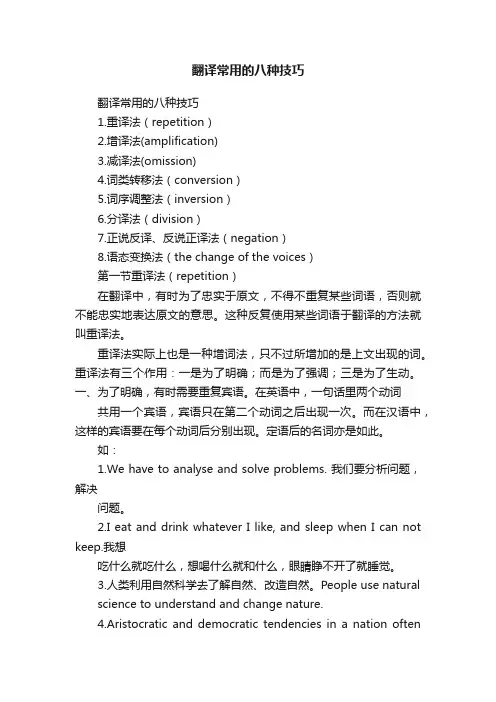
翻译常用的八种技巧翻译常用的八种技巧1.重译法(repetition)2.增译法(amplification)3.减译法(omission)4.词类转移法(conversion)5.词序调整法(inversion)6.分译法(division)7.正说反译、反说正译法(negation)8.语态变换法(the change of the voices)第一节重译法(repetition)在翻译中,有时为了忠实于原文,不得不重复某些词语,否则就不能忠实地表达原文的意思。
这种反复使用某些词语于翻译的方法就叫重译法。
重译法实际上也是一种增词法,只不过所增加的是上文出现的词。
重译法有三个作用:一是为了明确;而是为了强调;三是为了生动。
一、为了明确,有时需要重复宾语。
在英语中,一句话里两个动词共用一个宾语,宾语只在第二个动词之后出现一次。
而在汉语中,这样的宾语要在每个动词后分别出现。
定语后的名词亦是如此。
如:1.We have to analyse and solve problems. 我们要分析问题,解决问题。
2.I eat and drink whatever I like, and sleep when I can not keep.我想吃什么就吃什么,想喝什么就和什么,眼睛睁不开了就睡觉。
3.人类利用自然科学去了解自然、改造自然。
People use naturalscience to understand and change nature.4.Aristocratic and democratic tendencies in a nation oftenshowthemselves in its speech.民族的贵族倾向和民族倾向常在其言语中表现出来。
5.我们来修改安全规则和卫生规则吧。
Let’s revise our safety andsanitary regulations.二、英语常用省略,但为了明确,也为了强调某些内容,在汉语中常常要将省去的部分重译出来。

Eight translation techniques1.增译法(amplification);2.重译法(repetition);3.减译法(omission);4.词类转移法(conversion);5.词序调整法(inversion):6.分译法(division);7.正说反译,反说正译(negation);8.语态变换法(the change of the voices)Group competition1.I am looking forward to the holidays.我在等待假日的到来.2.Much of our morality is customary.我们大部分的道德观念都有习惯性。
3.Courage in excess becomes foolhardiness,affection weakness,thrift avarice.勇敢过度,即成蛮勇;感情过度,即成溺爱;俭约过度,即成贪婪。
4. Histories make men wise;poets witty;the mathematics subtle;natural philosophy deep;moral grave;logic and rhetoric able to contend.读史使人明智,读诗使人灵秀,数学使人周密,科学使人深刻,伦理使人庄重,逻辑修辞使人善辩。
5. As an Oriental,I cannot but be proud of your historic achievement.作为一个东方人,我不得不为贵国所取得的历史性成就感到骄傲。
Amplification 增译法Three types: Semantic amplification,Grammatical amplification,Rhetoric amplificationSemantic amplification1. The crowds melted away人群渐渐散开了.2. We were all greatly moved by his loftiness.我们都被他那种崇高品质所深深感染.3. He felt the patriot rise within his breast.他感到一种爱国热情在胸中激荡.loftiness patriot: 英语习惯运用抽象词汇,而汉语习惯运用具体词汇将“抽象概念变为具体概念”,类似词汇如:arrogance, indifference, tension,confusion, solution, remedies, jealousy, fault-finding增补概括性的词1. The advantages of the meeting room are bright, spacious, fashionable, and without echoes.这个会议室有四大优点:明亮、宽敞、时髦、无回声。
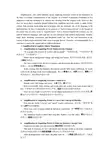
Amplification , also called addition, means supplying necessary words in our translation on the basis of accurate comprehension of the original. As a matter of principle, a translator is not supposed to add any meaning to or subtract any meaning from the original work. However, this does not mean that a translator should refrain from supplying necessary words to make his/her version both accurate in meaning and in keeping with the idiomatic use of the language to be translated into. In fact, it is precisely for the purpose of “faithful representation” of the thought of the author that we often resort to “amplification”. This is because English and Chinese are two entirely different languages and each has its own historical and cultural background. Besides, many ideas, idiomatic expressions and shorthand words, etc. That are well understood in the country of their origin can hardly make sense to people abroad. Therefore, it is unimaginable for a translator to stick to the orginal pattern without alteration.Ⅰ. Amplification in English-Chinese Translation1.Amplification by Supplying Words Omitted in the Original"if so grand, why so poor? If so poor, why so grand?" “既然那么阔,干吗要叫穷?既然那么穷,干吗摆阔气?”·Matter can be changed into energy, and energy into matter. 物质可以转化为能,能也可以转化为物质。
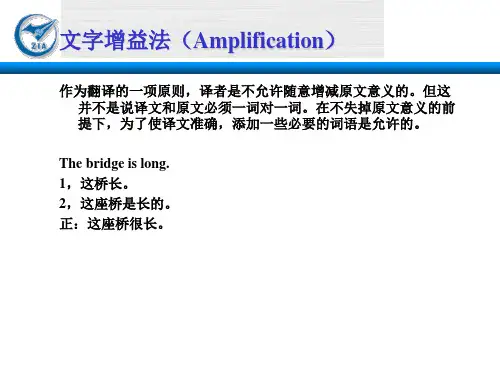
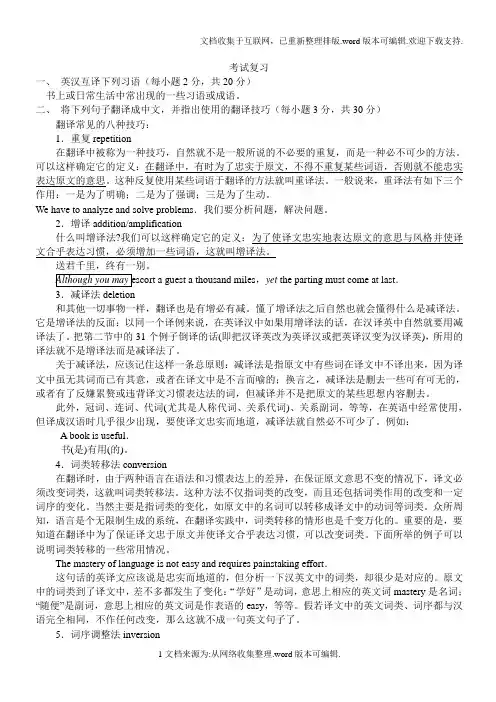
考试复习一、英汉互译下列习语(每小题2分,共20分)书上或日常生活中常出现的一些习语或成语。
二、将下列句子翻译成中文,并指出使用的翻译技巧(每小题3分,共30分)翻译常见的八种技巧:1.重复repetition在翻译中被称为一种技巧,自然就不是一般所说的不必要的重复,而是一种必不可少的方法。
可以这样确定它的定义:在翻译中,有时为了忠实于原文,不得不重复某些词语,否则就不能忠实表达原文的意思。
这种反复使用某些词语于翻译的方法就叫重译法。
一般说来,重译法有如下三个作用:一是为了明确;二是为了强调;三是为了生动。
We have to analyze and solve problems.我们要分析问题,解决问题。
2.增译addition/amplification什么叫增译法?我们可以这样确定它的定义:为了使译文忠实地表达原文的意思与风格并使译文合乎表达习惯,必须增加一些词语,这就叫增译法。
送君千里,终有一别。
,yet the parting must come at last.3.减译法deletion和其他一切事物一样,翻译也是有增必有减。
懂了增译法之后自然也就会懂得什么是减译法。
它是增译法的反面:以同一个译例来说,在英译汉中如果用增译法的话,在汉译英中自然就要用减译法了。
把第二节中的31个例子倒译的话(即把汉译英改为英译汉或把英译汉变为汉译英),所用的译法就不是增译法而是减译法了。
关于减译法,应该记住这样一条总原则:减译法是指原文中有些词在译文中不译出来,因为译文中虽无其词而已有其意,或者在译文中是不言而喻的;换言之,减译法是删去一些可有可无的,或者有了反嫌累赘或违背译文习惯表达法的词,但减译并不是把原文的某些思想内容删去。
此外,冠词、连词、代词(尤其是人称代词、关系代词)、关系副词,等等,在英语中经常使用,但译成汉语时几乎很少出现,要使译文忠实而地道,减译法就自然必不可少了。
例如:A book is useful.书(是)有用(的)。
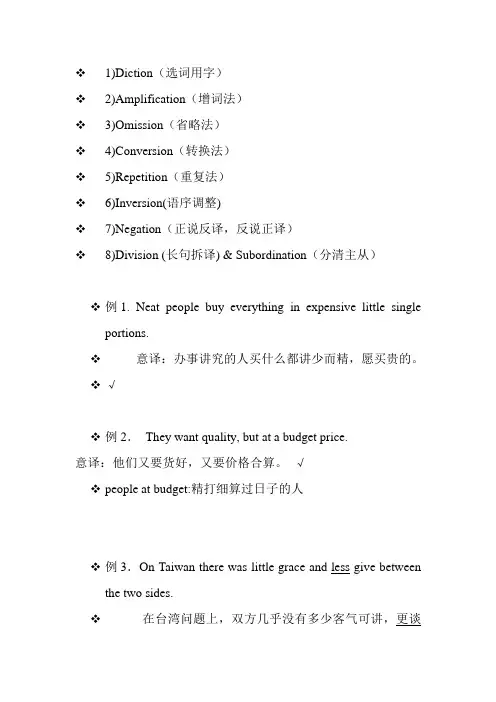
1)Diction(选词用字)2)Amplification(增词法)3)Omission(省略法)4)Conversion(转换法)5)Repetition(重复法)6)Inversion(语序调整)7)Negation(正说反译,反说正译)8)Division (长句拆译) & Subordination(分清主从)例1. Neat people buy everything in expensive little single portions.意译:办事讲究的人买什么都讲少而精,愿买贵的。
√例2.They want quality, but at a budget price.意译:他们又要货好,又要价格合算。
√people at budget:精打细算过日子的人例3.On Taiwan there was little grace and less give between the two sides.在台湾问题上,双方几乎没有多少客气可讲,更谈不上让步了。
例4. Whichever way you choose to visit Zhengzhou , you will reach here quickly and enjoy a comfortable stay, because Zhengzhou has a wide range of accommodation to suit all budgets and tastes…试译:无论乘坐何种交通工具都能迅速抵达郑州,下榻此处会让你倍感舒适,这里的住宿条件能充分满足各种档次和品味的要求……。
例4.New HSR and Maglev would have all-new, state-of-the-art train control system. The Accelerail options were estimate with train control systems providing speed and authority enforcement.译文:新型高速列车或磁浮列车须装置全新的、造形精美的列车操纵系统,可供选用的列车操纵系统必须能提供速度和(威力)强大的加速力。
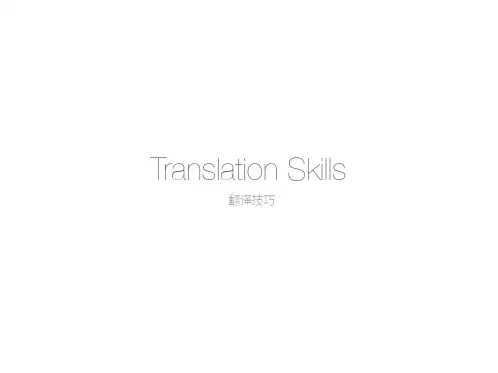
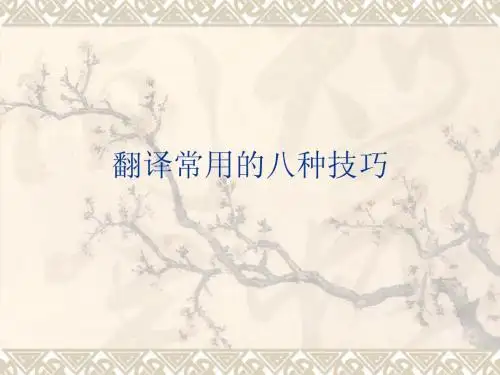

1.重译法(Repetition):为了忠实表达原文的意思,重复某些关键词。
作用:明确;强调;生动。
2. 增译法(Amplification)和减译法(Omission)增加或减少原文的一些词。
目的:使译文忠实地表达原文的意思与风格并使译文合乎表达习惯。
3. 词类转译法(Conversion)由于两种语言在语法和习惯表达上的差异,在保证原文意思不变的情况下,译文必须改变词类,这种方法不仅指词类的改变,而且还包括词类作用的改变和一定词序的变化。
Eg:(1)n.→v. the promotion of gender equality 促进性别平等(2)adj.→v. be independent of society 脱离社会(3)v.→n. be characterized by 特点是(4)adj→n. eloquent and elegant 既有口才,又有风度(5)n.→adj. independent thinking独立思考的能力注:词类转移要遵守忠实与通顺的原则。
4. 词序调整法(Inversion)翻译时对词序作必要或必不可少的改变,并不只是纯粹的颠倒词序或倒装。
5. 正义反译,反义正译(Negation)为了使译文忠实而合乎语言习惯地传达原文的意思,把原文中的肯定说法变成译文中的否定说法,或把原文中的否定说法变成译文中的肯定说法。
Eg: 正义反译:deny 否决,否定→不给予miss 错过→没赶上(交通工具);没听(看到)或没听(看懂)live up to one’s expectations 不(没)辜负……的希望divert attention from 将注意力从……移开→没有意识到be absent 未出席,没来far from 远非;完全不final 最终的→不可改变的idly 漫不经心地,无所事事地be at a loss 不知所措rather than/instead of 而不是absent-minded 心不在焉的but for 要不是;如果没有(2)反义正译no less than 实在是;正如;不少于no less…than 和……一样;不亚于no other than 只有;正是none other than (用以加强语气) 正是,恰恰是,不是别人,正是……nothing but 只有(是);只不过no choice but 别无选择,只(好)得unfold 展开,呈现disappear 消失,失踪carelessly 马马虎虎地,粗心地6. 分译法(Division)分译法主要用于长句的翻译。
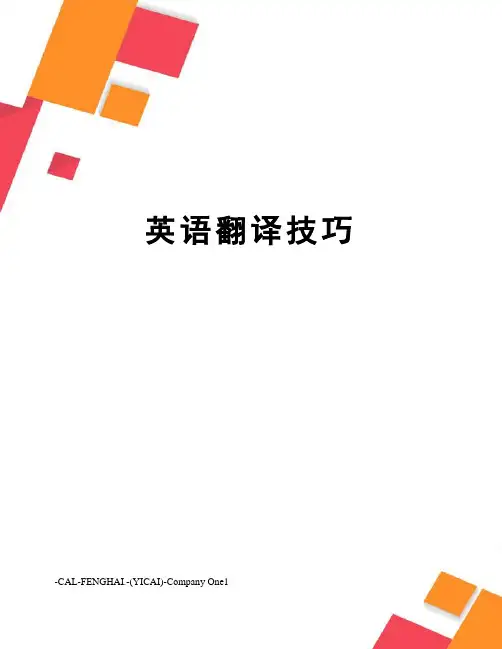
英语翻译技巧-CAL-FENGHAI.-(YICAI)-Company One1翻译技巧由于汉英两种语言在词法、句法上的差异,翻译并不是简单的一对一复制,而是根据具体情况,灵活地运用翻译技巧坐车必要的调整和改变,使译文最大程度地再现原文的意义,又使它符合译语的表达习惯。
翻译技巧大体分为八类。
它们是:加注(annotation)、释义(paraphrase)、增词(amplification)、减词(omission)、转换(shift of perspective)、归化(adaptation)、切分(division)和合并(combination)。
1.加注由于汉英文化的不同,英语中某些词义在汉语中根本不存在,形成词义上的空缺。
在这种情况下,常常采用加注法来弥补空缺。
加注可分为音译加注和直译加注两种。
音译加注指音译后附加解释性注释。
注释可长可短,可以在文中注释,也可采用脚注。
Cartoon 卡通片Hamburger 汉堡包Benz 奔驰车Hippie 嬉皮士(20世纪60年代出现在美国的青年颓废派一员,喜群居,蓄长发,穿奇装异服)El Nino 厄尔尼诺(现象)(指严重影响全球气候的太平洋热带海域的大风及海水的大规模移动)Saint Valentine’s Day 圣瓦伦丁节情人节,2月14日)1.Hygeia herself would have fallen sick under such aregiment; and how much more this poor old nervousvictim?2.3.You look like Al-Capone in that suit.4.He saw himself, in a smart suit, bowed into the opulentsuites of Ritzes.5.It’s true that the enemy won the battle, but theirs is buta Pyrrhic victory,” said the general.6.Nancy Reagan, and not George Gallup, may well havethe final say.直译加注指直译原文,并附加解释性注释。
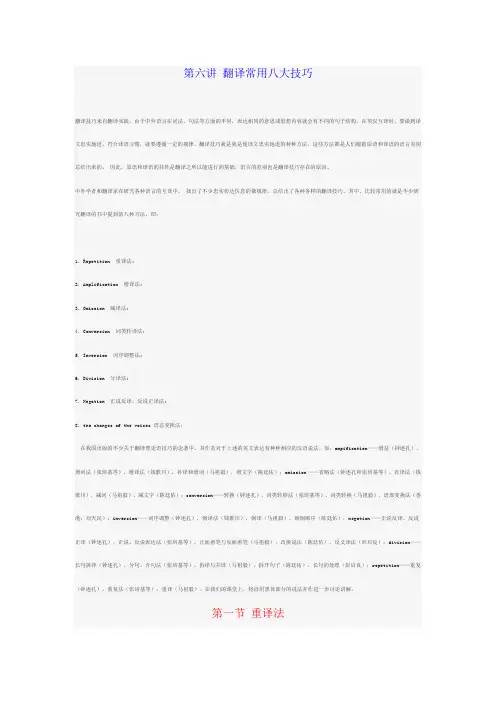
第六讲翻译常用八大技巧翻译技巧来自翻译实践。
由于中外语言在词法、句法等方面的不同,表达相同的意思或思想内容就会有不同的句子结构。
在英汉互译时,要做到译文忠实地道,符合译语习惯,就要遵循一定的规律。
翻译技巧就是就是使译文忠实地道的种种方法,这些方法都是人们根据原语和译语的语言差别总结出来的。
因此,原语和译语的共性是翻译之所以能进行的基础,语言的差别也是翻译技巧存在的原因。
中外学者和翻译家在研究各种语言的互译中,找出了不少忠实传达信息的俄规律,总结出了各种各样的翻译技巧。
其中,比较常用的就是不少研究翻译的书中提到的八种方法,即:1. Repetition 重译法;2. Amplification 增译法;3. Omission 减译法;4. Conversion 词类转译法;5. Inversion 词序调整法;6. Division 分译法;7. Negation 正说反译、反说正译法;8. the changes of the voices 语态变换法;在我国出版的不少关于翻译理论语技巧的论著中,其作者对于上述的英文表达有种种相应的汉语说法。
如:ampification——增益(钟述孔),增词法(张培基等),增译法(钱歌川),补译和增词(马祖毅),增文字(陈廷佑);omission ——省略法(钟述孔和张培基等),省译法(钱歌川),减词(马祖毅),减文字(陈廷佑);conversion——转换(钟述孔),词类转移法(张培基等),词类转换(马祖毅),语部变换法(香港:刘天民);inversion——词序调整(钟述孔),倒译法(钱歌川),倒译(马祖毅),颠倒顺序(陈廷佑);negation——正说反译、反说正译(钟述孔),正说、反说表达法(张培基等),正面着笔与反面着笔(马祖毅),改换说法(陈廷佑),反义译法(彭启良);division——长句拆译(钟述孔),分句、合句法(张培基等),拆译与并译(马祖毅),拆开句子(陈廷佑),长句的处理(彭启良);repetition——重复(钟述孔),重复法(张培基等),重译(马祖毅)。
翻译常用的八种技巧1.增译法、增词法:amplification2.重译法、重复法:repetition3.省译法、减词法:omission4.词性转换法、词类转移法:conversion5.正说反译、反说正译法:negation6.语态变换法:the change of the voices7.分译法、分句法(OPP:合句法):division8.语序调整法、词序调整法(顺序法与逆序法)inversion增词法译文中添加一些原文没有的词句,表面上看似不忠实于原文,但仔细分析就会发现这些增加的词句所表达的意思并非无中生有,而是隐含在原文中的。
要知道,从一种语言文字向另一种语言文字转换,有时可以找到一种语言文字在另一种语言文字中的对等词,然而要想全部依赖对等词的转换来达到翻译的目的是几乎不可能的。
不同语言文字所持有的习惯决定了必须根据其中一种语言文字的习惯来适当地增词(或减词)达到语言交际的目的。
如果机械地按照字面意义直译,不仅不能表达原文的思想,精神与形象,而且还会使译文前后矛盾,闹出笑话。
例1 听到你平安的消息,非常高兴!译文: I was very glad on hearing that you were in safety!例2对不起,打扰一下!译文: Excuse me for interrupting you!(增补作宾语的代词you)例3 Histories make men wise; poems witty; the mathematics subtle; natural philosophy deep; moral grave; logic and rhetoric able to contend.译文:读史使人明智,读诗使人灵秀,数学使人周密,科学使人深刻,伦理使人庄重,逻辑修辞之学使人善辩。
(译文中添补了谓语和宾语:增词法;重译法)例4:We won’t retreat, we never have and never will.译文:我们不后退,我们从来没有后退过,我们将来也绝不后退。
基本的翻译技巧一般包括1).Diction(选词用字); 2).Amplification(增益); 3).Omission(省略);4).Repetiton(重复); 5).Conversion(转换); 6).Restructuring(词序调整); 7).Negation(正说反译,反说正译); 8).Division(长句拆译).遣词用字是任何翻译工作者自始至终需面临的一个现实问题。
由于英汉分属不同的语系,所以在翻译时源语与译语之间往往没用相对固定的词义对应关系。
本期用对比的方式归纳了英汉词字层次上的五种对应情况:1.完全对等,2.多词同义,3.一词多义,4.词义交织,5.无对等词语。
词义辨析是遣词用字的前提。
本期从四个角度探讨了如何判断某一英语词语的准确含义,即1.根据构词法辨别词义;2.根据指代关系辨别词义;3.根据上下文或词的搭配辨别词义;4.根据不同学科或专业类型辨别词义。
在词义辨析的基础上,本期归纳了英语词语翻译的8种常用技巧:1.推演法,2.移植法,3.引伸法,4.替代法,5.释义法,6.合并法,7. 图形法和8.音译法。
1. Correspondence Between English and Chinese at Word Level----英汉词字层次上的五种对应情况In most cases there is no existing pattern for sentence translation, nor are there fixed rules for word transfor mation. Generally speaking, the correspondence between English and Chinese at word level may be categori zed as follows:1) Word-for-word CorrespondenceThis is most evidently shown in proper nouns and technical terms.For example: Marxism = 马克思主义Aspirin =阿斯匹林2) One Word with Multiple Equivalents of the Same MeaningThis is a common case in translation.For example:犬:dog, hound, spaniel, mastiff, pointer, setter, retriever, terrier……3) One Word with Several Equivalents of Different MeaningThis is also very common in translation. For example:carry: 搬、运、送、提、拎、挑、担、抬、背、扛、搂、抱、端、举、夹、捧…..走:walk, saunter, amble, stride, trudge, trapes, shamble, prance, scamper, clump, tiptoe ….羊: sheep, goat, ram, ewe, lamb……4) Equivalents Interwoven with One Another5) Words Without EquivalentsIn this case, an explanation is given instead of an equivalent.For example:clock-watcher: 老是看钟等下班的人阴: (in Chinese thought) the soft inactive female principle or force in the world阳: (in Chinese thought) the strong active male principle or force in the world(目不识)丁: (not know one's) ABC2. Methods to Discriminate the Original Meaning of an English Word-----词义辨析Since English words are prone to various meanings, it is of vital importance for a translator to discern the rig ht meaning of a given word. And the following are the major methods of discriminating word meaning sugge sted by some linguists.1) Judging from the Word FormationIn order to discriminate the original meaning of an English word, it is necessary for us to have a knowledge of English lexicology, and specifically, a knowledge of word formation, such as compounding, derivation, af fixation, blending, acronym, clipping, etc. A good command of them will help to shed light on the correct me aning of some difficult words.For example, the word ""parabiospheric"", which consists of para-(outside) +bio-(biologic) +spheric (havingthe form of a sphere). After a brief analysis, we may safely put it into ""外生物层的"". Another more complicated instance, pneumonoultramicroscopicsilicovolcanoconiosis. This extremely lon g word seems appallingly complicated. However, an anatomic study of its composition enables us to get a cl ear understanding of its meaning: pneumono- (of lung) +ultra- (beyond) + micro (very small) + scopic- (of vi ewing or observing) + silico- (of silicon)+ volcano + coni- ( koni, of dust) + osis (forming the name of a dise ase). Even if we are not sure of the equivalent of this medical term, we may roughly get the right meaning of the long word: a kind of lung disease caused by extremely small silicon particles. And a look into some dicti onary leads us to the definite answer: 硅酸盐沉着病,肺尘病(一种矿工易染的病)。
2.十种翻译技巧了解完四种翻译方法后,我们再来了解一下十种常用翻译技巧,即重复法(repetition),增词法(amplification),省略法(omission),词类转换法(conversion),词序调整法(inversion),拆译法(division),正说反译和反说正译法(negation),语态变换法(voice changes),引申法和句子成分转译法。
2.2.1重复法(repetition)重复法(repetition)是在翻译中,为了使译文忠实于原文并且产生意义明确,文字通顺、流畅,符合目的语习惯的文字,而将某一部分文字反复使用的翻译技巧。
例子:1. You must ask the mother at home, the children in the street, the ordinary manin the market and look at their mouth, how they speak, and translate that way; then they’ll understand and see that you’re speaking to th em in German. (重复谓语动词)你一定要问一问家庭主妇们,问一问街头玩耍的孩子,问一问集市上做买卖的百姓,听听他们说些什么,他们如何说,你就如何译;这样他们就会理解,就会明白:你是在用德语和他们讲话。
2. We have to analyze and solve problems. (重复宾语)我们必须分析问题,解决问题。
3. Ignorance is the mother of fear as well as of admiration. (重复省略的部分) 无知是畏惧之源,羡慕之根。
4. But we still have defects, and very big ones. (指代内容的重复)但我们仍有不足,而且是很大的不足。